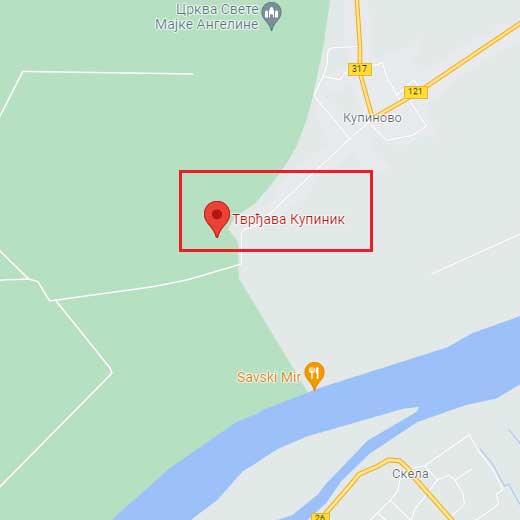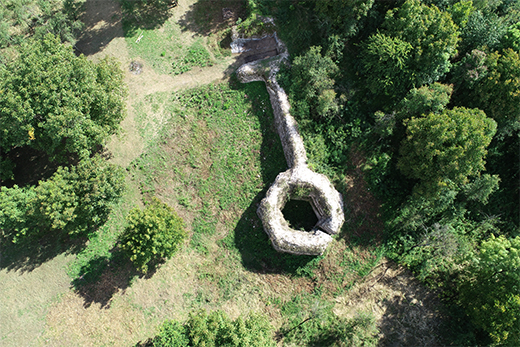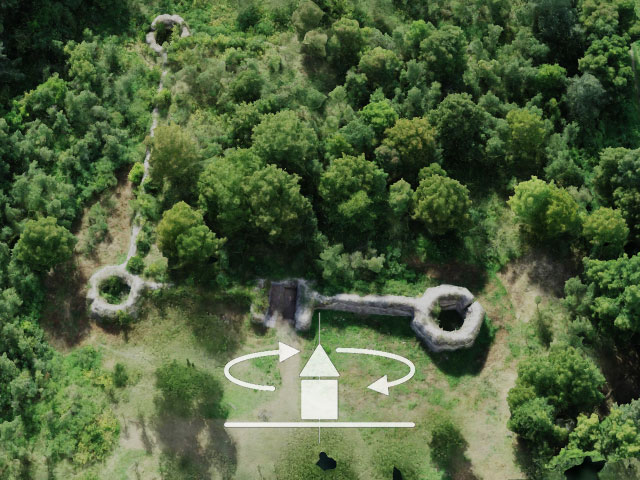Kupinik Fortress
Protected cultural monument of great significance, listed as SK 1264 with the Republic Institute for the protection of monuments of cultural heritage.
Kupinik FortressKupinovo, Pećinci municipality, Srem District
Where is it
Kupinik Fortress is located in the village Kupinik, in Lower Srem, also called Podlužje. It was built on a small island, in a still water pond next to the river Sava, now known as nature reserve, Obedska bara. The shortest road from Belgrade to Kupinik is via Surčin and is 46 km long. It is also accessible via Obrenovac bridge, if one is coming south from the Sava. However, the most important access is certainly from the E-70 highway Belgrade-Batrovci, which is an arm of the Corridor 10.

History
The oldest mention of Kupinik is in the two charters by the Hungarian king Sigismund, from the second half of 14th century (1387 and 1388). It was built as a military-border fortification on the border between Hungary and Serbia. In the early 15th century, Stefan Lazarevic received Kupinik from the Hungarian king Sigismund and it became the seat of the Branković family. It was then that the fortress was fortified, especially the ramparts, in order to prepare for the war with the Turks. The ramparts obtained cannon towers.
After Stefan’s death, Djuradj Branković inherited the Kupinik fortress, which then developed as a border place convenient both for military control and the trade. After the fall of Smederevo in 1459, Kupinik became the last capital of Serbian despots, the capital city of the last Brankovićs.
After the death of despot Djuradj, Kupinik was once again taken over by the Hungarian king.
It was destroyed by Sultan Suleiman who, during his Belgrade campaign in 1521, destroyed other fortresses on the Sava.
Reserach
Kupinik fortress has not been archeologically researched yet. Superficial findings of the archeological material point out that there might have been a Roman or late antique fortress in the area, while discovered stone tools suggest that the place was inhabited as early as the neolith.
Archeological research that begun in 2021 has as its aim the discovery and study of Kupinik in order to research and revitalize the fortress, in cooperation with the Pećinci municipality.
The plan for detailed regulation of the archeological site Kupinik Fortress was made in 2016 and it entails a detailed research, renewal and revitalization of the fortress through various cultural, historic and touristic content.

Description
The fortification is shaped as an irregular rectangle whose dimensions are 57х57m, with protruding towers at each corner, each differently shaped. The remains of three of those are preserved today. The entrance to the fortress, on the southeastern rampart, was protected by the fifth tower. The best preserved is the octagonal northern tower, whose height is currently at 8m but it is supposed to have been double that height. The 8m tall ramparts were built with crushed stone and covered with brick on the outside. Around the ramparts there is a 3-meter deep and 17-meter-wide trench that protected the city from the intruders. Since the water trench surrounded the city from all sides, the main gate was accessible from the mainland only via a drawbridge.
Kupinik was destroyed immediately after Suleiman I Magnificent conquered Belgrade and then the entire Srem. It has not been renewed since.
Between 1455 and 1457 despot Djuradj built the court church dedicated to St. Luka, next to the fortification, accessible by a bridge. This is the oldest Orthodox church in Vojvodina and in 1486 the earthly remains of Stefan Branković were placed there. Around the church, the settlement Kupinik was later formed.
The Order of the Dragon and Dragon-heroes
As a token of friendship to the heroes of the Order of the Dragon, Kupinik was gifted to despot Stefan Lazarevic by the Hungarian king in 1402, after the Angora battle. Under the leadership of Stefan’s vassal, Radić Postupović, the city was an important center of the Order of the Dragon, an alliance that the Christian rulers formed in order to join forces against the Ottomans. In 1476, during his conquest of Šabac, the Order was joined by the Transylvanian ruler Count Vlad the Impaler.
After Stefan, the old despot Djuradj Branković inherited Kupinik in 1472 and often stayed there. It was also ruled by Vuk the Fiery Dragon (Vuk Branković), Angelina of Serbia with her sons Djordje and Jovan, and the last despot Stefan Berislavić.
Julka Kuzmanović Cvetkovićarcheologist
